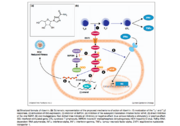Ribavirin
From Proteopedia
(Difference between revisions)
| Line 1: | Line 1: | ||
1-β-D-ribofuranosyl-1H-1,2,4-triazole-3-carboxamide <ref name="gish">DOI: 10.1093/jac/dki405 </ref> | 1-β-D-ribofuranosyl-1H-1,2,4-triazole-3-carboxamide <ref name="gish">DOI: 10.1093/jac/dki405 </ref> | ||
<StructureSection load='' size='340' side='right' caption='Ribavirin PDB [[4PB1]]' scene='74/746008/Ribavirin_atalla2/1'> | <StructureSection load='' size='340' side='right' caption='Ribavirin PDB [[4PB1]]' scene='74/746008/Ribavirin_atalla2/1'> | ||
| - | + | ||
== Overview == | == Overview == | ||
| Line 7: | Line 7: | ||
== Structure & Function == | == Structure & Function == | ||
| - | While the main function of Ribavirin is to treat Hepatitis C and RSV, Ribavirin alone is not enough to treat these diseases and is commonly combined with interferon alfa2b. Ribavirin contains antiviral activity which inhibits DNA/RNA synthesis.The structure of Ribavirin resembles the structure of the nucleoside guanosine. Like guanosine, ribavirin is also water soluble and is able to mimic other purines as well. However, a key difference between the structure of ribavirin and the purine nucleosides is that it’s heterocyclic base contains only one ring, as opposed to purines which have two. Despite this, it is able to go through similar mechanisms as that of nucleosides such as phosphorylating into a triphosphate. It’s structural similarity to the common nucleoside guanosine may suggest how the drug can inhibit DNA/RNA synthesis through purine mimicry. | + | While the main function of Ribavirin is to treat Hepatitis C and RSV, Ribavirin alone is not enough to treat these diseases and is commonly combined with interferon alfa2b. Ribavirin contains antiviral activity which inhibits DNA/RNA synthesis.The structure of Ribavirin resembles the structure of the nucleoside guanosine. Like guanosine, ribavirin is also water soluble and is able to mimic other purines as well. However, a key difference between the structure of ribavirin and the purine nucleosides is that it’s heterocyclic base contains only one ring, as opposed to purines which have two. Despite this, it is able to go through similar mechanisms as that of nucleosides such as phosphorylating into a triphosphate. It’s structural similarity to the common nucleoside guanosine may suggest how the drug can inhibit DNA/RNA synthesis through purine mimicry. <scene name='74/746008/Ribavirin_atalla2/1'>Ribavirin</scene> |
== Disease == | == Disease == | ||
Revision as of 03:45, 16 November 2016
1-β-D-ribofuranosyl-1H-1,2,4-triazole-3-carboxamide [1]
| |||||||||||
References
- Gish, R. G. (2005, November 17). Treating HCV with ribavirin analogue and ribavirin-like molecules. Journal of Antimicrobial Chemotherapy, 1-6. doi:10.1093/jac/dki405
- Chung, R.T., Gale, M.J., Polyak, S.J., Lemon, S.M., Liang, T.J., & Hoofnagle, J.H. (2008). Mechanisms of action of interferon and ribavirin in chronic hepatitis C: Summary of a workshop. Hepatology, 47 (1), 306-320. doi: 10.1002/hep.22070
- Paeshuyse, J, Dallmeier, K, Neyts, J. (2011). Ribavirin for the treatment of chronic hepatitis C virus infection: a review of the proposed mechanisms of action. Current Opinion in Virology. 1(6): 590-598. doi: 10.1016/j.coviro.2011.10.030
- National Heart, Lung and Blood Institute. (2016, September 26). Pneumonia. Retrieved from https://www.nhlbi.nih.gov/health/health-topics/topics/pnu
- Foster, G. (2010). Pegylated interferons for the treatment of chronic Hepatitis C. Drugs. 70(2):147-165. doi:10.2165/11531990-000000000-00000
Proteopedia Page Contributors and Editors (what is this?)
Jamie Costa, Edmond R Atalla, Katherine Reynolds, Taylor H. Derby, Shannon Shaughnessy, Alexander Berchansky

